Author Archives: 2010admin
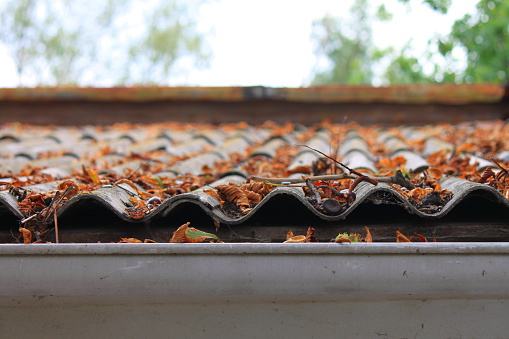
With winter creeping up as quickly as summer passed, now is a great time to get maintenance projects out of the way. Before things get too chilly, take advantage of the fall season to complete some necessary to-dos around the house that will help keep it in great shape throughout the harsher months to come. There are some tasks that really can’t be ignored to keep your home in its best condition – so make sure to take on these ones first!
Maintain Your Gutters
Whether you hire a professional pressure washer or take on the job yourself, your gutters really need a good clean before winter. Debris and wet leaves can accumulate quickly and only compound throughout the fall season, clogging up your gutters so they can’t function properly. With all the precipitation winter brings, you want your gutters to be prepared so they can protect your property from water damage.
While you’re at it, make sure your gutters are aligned properly! Ice from past winter seasons can take a toll, causing them to sit off-kilter. If they’re not straightened before winter, your roof could be swamped in the Spring.
Store Summer Away
Once fall hits, all your summer outdoor items can be stored away for winter to maintain their longevity. First, take care of all your patio furniture and outdoor living space pieces. Covering them with a blanket will help to keep them from getting damaged by the weather or in storage.
Next, take down and store your window screens. Even if you do enjoy opening them at times in the fall or winter, you certainly won’t need to keep bugs at bay. Storing your screens during these seasons extends their lifespan. But before you put them away, give them a gentle cleaning with a soapy bucket of water and brush so they’re ready for springtime.
Lastly, pack up your plants! Adding an extra layer of mulch to your flower bed will help protect your plants so they can flourish again next year.
Finesse Your Furnace
You want to make sure your furnace is ready for those chilly fall nights and frigid winter days. And bleeding your hot water radiators is an easy way to keep them from holding excess water and air. Unscrew the valve at the top, and then catch the water in a small container.
You can also change your furnace filter yourself, keeping your indoor air from getting dirty and your furnace functioning well. Pro tip: make sure to do this before the first time you turn it on for the season.
Finally, make sure you get your routine furnace maintenance inspection. That way, with the help of a pro like those here at Madsen, you can take care of any repairs before it gets too cold outside. Don’t wait to find out your furnace isn’t working properly the hard way – get your inspection done in the fall to make sure you’ll be comfortable all winter long.
Do a Safety Check-Up
Fall is also a great time to check on your detectors and fire extinguishers. Your smoke detectors and carbon monoxide detectors should both get fresh batteries. Just a note, if your carbon dioxide detectors are right next to your furnace, they might go off when you turn it on for the first time. Make sure you get your furnace inspection with Madsen to check on those carbon dioxide levels to give you peace of mind in the upcoming months.
Prep Your Space for Snow Removal
Don’t make things harder on yourself this winter. Whether you’re using a snow blower or grabbing a shovel, you’ll want to make sure your space is cleared and ready for snow removal (another great reason for putting that outdoor furniture away!). Rocks, hoses, cords, and dog runners can become big hassles if not taken care of ahead of time. Clear the path so you can get rid of the snow without any additional effort.
Taking care of those beautiful fall leaves can also be a big help in the winter. You don’t want a layer of wet leaves adding weight to the heavy snow as you shovel or clogging up your snow blower. Picking up that rake now can make picking up the shovel much easier when the time comes!
By taking care of these important maintenance projects this fall, your home will be ready for winter’s worst! And for all those furnace-related issues, we’re here to help you at Madsen! Contact us today to help you finish up your fall maintenance so you can be cozy and comfortable all winter long.
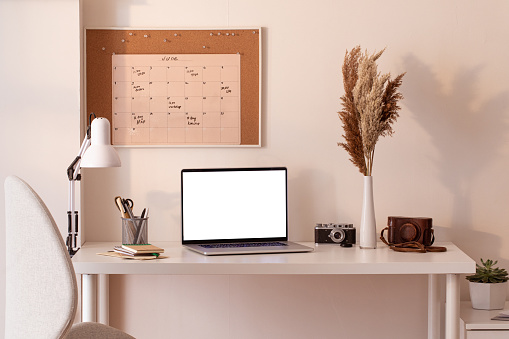
Now that so many people have transitioned to remote and hybrid work models, it’s become apparent just how valuable a distinct home office area is to stay productive. If you’re working from home full-time or a couple of days a week, having a distraction-free space that encourages creativity and focus is a must.
Here at Madsen, we’re all about designing spaces that help you to live your best life and accomplish all your goals. There are some simple ways to design your home office environment so that it’s not only functional, but also inspirational. Use these tips to upgrade your home office to meet all your professional needs.
- De-Clutter Your Desk
When you don’t have room to work, it can be very distracting and inhibiting to simple tasks. Physical clutter leads to mental stagnation and can be overwhelming when you’re trying to focus. Simple organizational hacks can make your area more manageable, helping you create a space for you to thrive.
Using hooks to place hardware on your walls can free up a great deal of desk space. Adding extra storage to your desk in the form of drawers, shelves, or sorters can also save you a lot of time wasted searching for things. When you have some sort of organization system for papers and tools, it will make finding and using them more efficient. And that includes having some sort of organizer for your computer and monitor cables. The less de-cluttered your space, the better you can achieve a healthy frame of mind.
And when you are re-organizing your desk, think about the accessibility, and make sure to prioritize frequently used items. If it’s not something you use every day, it can afford to be a little more hidden than if it’s something you do.
- Incorporate Effective Lighting
If your workspace isn’t well lit, it can cause strain on your eyes and even make you feel drowsy or depressed. Ideally, a mix of natural light and moveable task lighting is best. Setting your desk up near a window can bring you the presence of natural light during the day, which is even better! For task lighting, getting a desk lamp with a color-changing bulb will allow you to enjoy the perks of warm light, or yellow tones, to enhance creativity, and cooler light, or blue tones, for deeper concentration.
- Bring In Sources of Inspiration
Having items that bring you joy surrounding your workspace can make your space more comfortable and enjoyable when you’re stuck there for long periods of time. Plants and artwork are additions that provide a soothing sense of calm, while personal items that remind you of the people or things in your life that are most important can help keep you motived — and in a good mood! Incorporating bright colors throughout your space makes it an uplifting place to be and can also help the space feel larger. When you’re in the presence of some of your favorite things, you can’t help but feel rejuvenated!
- Make it Comfortable
Sitting in a wooden chair with no support is a great way to make sure you won’t be staying there for long. Having a comfortable, ergonomic chair with back supports and/or floor support will make the time spent in your workspace far more enjoyable. It’s also extremely important for overall health. Ergonomic office furniture is uniquely and specifically designed to minimize pressure points and encourage blood flow to help fend off aches and pains that can not only be distracting but cause more serious health issues down the road. So if you’re tempted by that super cute designer chair that goes great with your desk lamp, maybe give it another thought.
- Divy Up Your Space
Putting a desk in the middle of the den isn’t really the best way to be productive. While it may help you keep an eye on the kids, it’s not going to help you finish that brief in time to have dinner with them. Having somewhere that’s clearly defined as your workspace fosters a productive mentality, providing a clear separation from your work life and personal life. Using a room divider or transforming a bonus room or unused space with the help of the experts at Madsen can make it easier to avoid the distractions of being home and put you in the right headspace when it’s time to get things done. Lastly, separating yourself from your entertainment devices will serve you in the long run, allowing you to accomplish what you need to without temptation.
Bringing All These Elements Together
By making some of these changes to your home office environment, your space will be rich with joyful and inspiring elements that promote concentration, comfort, and productivity. You’ll find that these upgrades allow you to focus longer without becoming overwhelmed or distracted. Be the best version of your work self that you can be in an environment designed to encourage you every step of the way. Contact the Madsen team to talk about your home office goals today.
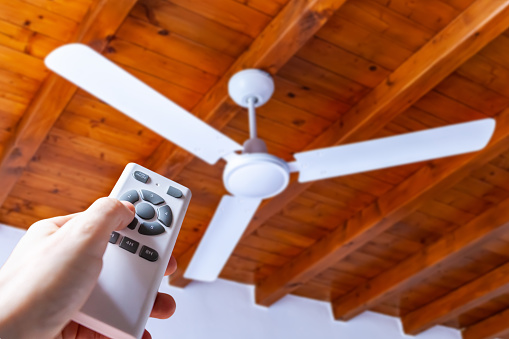
During the summer, there’s always a tug-of-war between keeping your home refreshingly cool and keeping your utility bill in check. And with today’s rising energy costs, the struggle is even more real this year. But there are some ways you can help you beat the heat while putting energy efficiency to work in your favor! We’ve put together a list of the usual culprits that raise home temps and tips to help you bring the cool back into summer.
Keep Out the Sunlight
Sunlight is the antagonist of keeping cool — period. Luckily, there are a few easy ways to keep it from getting to you. Window coverings, especially for windows that face west or south, can help keep sunlight at bay, minimizing the warmth that accumulates within your home. Thermal curtains, thermal shades, blackout curtains, heat-reducing film, and interior shutters are all great, affordable options that can help to achieve this desired outcome. For the outside of your windows, planting shady trees or installing an awning on the west or south-facing sides of your property will take care of that searing sunlight as well.
Ask the Experts
A second opinion from experienced professionals could be just what you need to keep your home as cool as it can be for the lowest cost. Your local utility company will be happy to provide you with an energy audit. This process identifies cracks and crevices in your home — such as around windows, door frames, and crawl spaces — where the warm air is seeping in. In fact, energy efficiency experts from the Natural Resources Defense Council say that these small openings in the average home would add up to a hole the size of a basketball. Imagine all that heat! Some diagnostic testing can help you to identify the problem areas, not only arming you with the knowledge so you can take action, but also possibly rewarding you in rebates if you take the advice of your utility company afterward. When it comes to cooling, knowledge really is power!
Use Your Ceiling Fans at the Right Time
If you have ceiling fans, use them! When combined with your AC, the moving air can make a room feel much cooler. But that doesn’t mean use them all the time. Ceiling fans are very useful when you’re in the room, as the cooler air currents can make you feel 10 degrees cooler as it hit your skin. But when you’re not in the room or your AC isn’t on, don’t expect them to do much. In fact, they are just using additional unnecessary energy, which is what you’re trying to avoid. If you are in a bedroom or living space that has one, make sure it run them counterclockwise to draw the cool air downwards. And when you leave, you can leave them off.
Insulate
Insulation is also key, especially for your ceilings and attic areas. Most of the heat is coming from above, cooking your home with the sunlight beating down on your roof — not to mention it also rises from below. While it’s often thought to retain heat in homes, adding some insulation to the upper parts of your property can actually fight off the strong summer rays and keep the heat out. If you can invest in some insulation, your AC will be much more effective, and its impact will last longer, allowing the cool air it produces to stay put and that pesky heat out so it can’t warm it back up again.
Use the Right Cooling System
Lastly, it all comes down to the AC and the thermostat. We’re proud to offer energy-efficient systems and programmable thermostats to help keep your energy costs low and your home feeling cool. With a programmable (or smart) thermostat, you can set your temperature to be slightly warmer when you’re not home and set it to your desired temperature before you arrive home, so that you’re greeted by a cool and refreshing feeling when you get there. And if you ever do forget to set it, you can adjust it from anywhere — the car, work, vacation — proving to be a life saver for those of us who tend to be more forgetful than most. If you’re considering installing a new thermostat or upgrading your HVAC equipment, contact us today to find out which products would be best for you!
Other helpful tips:
- Close the blinds
- Minimize the use of the oven or stove – grill more!
- Make sure doors to unused rooms are closed
- Clean your AC filters regularly
When it comes to cooling your home, the difference is in the details. By making a few subtle changes, your home is guaranteed to stay cooler and more comfortable all summer long. Don’t break the bank by blasting the thermostat all July and August — contact the pros at Madsen Inc. for more tips and information on ensuring your cooling system is working for you.
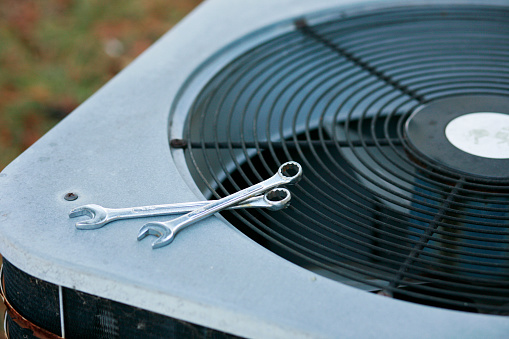
Without fail, air conditioning issues always seem to happen at the worst times — like on the hottest day of the year or right when you plan on having guests over. That’s because you can’t just turn your AC on high after a long winter or mild spring and expect it to run flawlessly. These units are complex and just like a lot of other equipment in your home, they need routine, seasonal maintenance.
Have you been putting it off? Our goal is to help you see why that’s a bad idea. Here are a couple of reasons why your AC system needs regular maintenance and a few signs that you’re overdue for a repair or replacement.
- Prevent a dreaded breakdown
This is the worst case scenario, but it’s also not uncommon. The main reason to call a pro each year is to avoid a breakdown right when you need your system running the most. During their routine visit, they’ll clean the entire system, check for any faulty parts, look at the electrical and compressor systems, and fine tune any components that need it. An expert will make sure everything will run smoothly in the upcoming season without any unwanted surprises. - Save on repair bills
Even if your system isn’t quite on the brink of a breakdown, it may have underlying issues that are preventing it from running properly — even if it isn’t that obvious. By putting off a maintenance check, you’re only allowing those issues to continue doing harm to your system. Why a repair may be needed after the annual inspection, it will likely be a lot cheaper than if you let it go for another couple of years. Why wait? - Prolong its lifespan
Everyone wants their AC unit to keep running as long as possible — replacements are expensive! A professional tune-up every year is the simplest way to prolong your system’s lifespan. By inspecting and fixing any issues in regular intervals, you can prevent one part of the system impacting the others and taking its toll on the whole unit.Fun fact: units that are regularly maintained can last up to 15 years without a replacement. - Boost your energy efficiency
Running your system in the spring and summer obviously isn’t free. But with those bills being higher than ever, anything you can do to keep them low without sacrificing your comfort is worth it, right? With the cleaning and repairs of a routine maintenance visit, your system can run more efficiently, reducing electricity consumption and saving you up to a couple of hundreds of dollars a year depending on the age of your unit.
Thinking it may be time for a professional checkup? If we haven’t convinced you to make the call yet, here are some red flags that let you know for sure.
- Hot spots. Your AC should be cooling evenly throughout your home. If some areas are warmer or cooler than others, there may be an issue with one of the system’s components.
- Rising Energy Bills. We know everything is on the rise right now, but keeping an eye on your bill month to month may help you notice some increases that don’t quite make sense in relation to your usage. This is where even just a good clean can make a huge difference.
- Thermostat Issues. As your AC command center, if your thermostat isn’t communicating properly with your unit then it may be a system issue.
- Little or Warm Air. If your vents are blowing warm air or no air at all, you definitely have a problem that a professional can help address.
- Loud Noises or Strange Odors. When your AC system is running properly, neither of these things should be happening.
- Freon or Water Leaks Around the Unit. Moisture leaking in or around your system is likely an indication of a refrigerant leak. Freon is poisonous, so contact a pro immediately.
To learn more about how to keep your energy bills as low as possible and your family as comfortable as possible this summer, the experts at Madsen Inc. are here to help. Contact us today to schedule your annual AC maintenance check today.
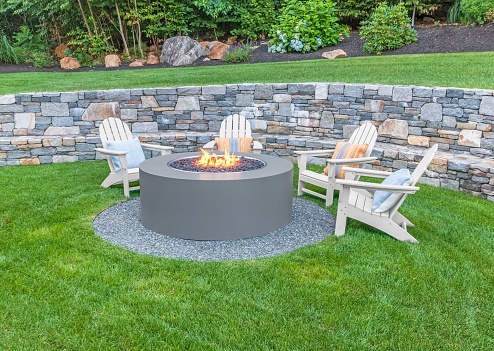
The backyard is probably one of the most versatile spaces of a home. It offers all kinds of additional livable square footage for entertaining or relaxing that a lot of homeowners simply don’t take advantage of. Not to mention, many improvements to your outdoor space can boost your home’s value big time.
So instead of spending this summer cooped up inside, here are six outdoor projects to turn your yard into the ultimate hub of your home.
- Fire Pit
The best thing about an outdoor firepit is that it makes being outside more comfortable when the chilly seasons arrive, which means you can spend more time enjoying your backyard. Building a firepit yourself can be a fun and rewarding project, but if you’re not interested in DIY, installing a $6,000 – $8,000 custom fire pit will on average increase your home’s ROI by 60-70%. In addition to all the great smores and good times you’ll get out of it, that sounds worth it to us!If you don’t have the space to build a permanent structure, a portable fire pit set up can certainly do the trick! That way you can bring it out and put it away whenever those chilly nights call for some long fireside snuggles.
- A Patio or Deck
Adding a patio or deck off the back of your home literally creates an extension of it. It will increase your livable outdoor space while adding the perfect canvas for a boatload of other great outdoor additions as well — from an outdoor bar, grill, lounge chairs, sound system, and even a whole kitchen (which we’ll touch on next). Tiered or multi-level decks are also very popular right now, adding interest and more value to your backyard experience.But before you start planning the first BBQ, there’s a few things you’ll have to do first when adding a deck. Check with your local ordinances to see what is required by the municipality’s code to build a deck. And then hire a professional engineer to ensure the joists are properly spaced and there are enough footings.
- Outdoor Kitchen
We don’t know about you, but it seems pretty unfair that while everyone else is out enjoying the sunshine, the chef of the party is stuck inside preparing the food. The surging popularity of outdoor kitchens is allowing homeowners to bring the best parts of their home outside! Many homeowners are choosing to make their spaces stand out with built-in grills and L-shaped islands with sinks and ice chests. Prepping areas and undercounter refrigerators are popular, as well as roofs with ceiling fans or heaters to keep things comfortable throughout any season. Truly functional outdoor kitchens can help a home truly stand out with up to a 200% ROI — and an even higher ROE (return on enjoyment).
If you’re not interested in a full kitchen, consider a wood-fire pizza oven, built-in grill with workspace, or even a patio bar. When you can spend more time outside than inside cooking, everyone wins.
- Privacy/Shade Structures
If you have a large backyard without a lot of trees or shaded areas, it’s hard to enjoy it on those hot summer days. A pergola is a great addition to any open space with multiple additions that can increase your comfort — and your home’s value — even more. Install electrical outlets to add lights or even a roof with ceiling fan to improve functionality. Throw in a rug, some cushioned furniture, and container planting to create the perfect space for any mood. Kick back with a good book, host a game night, enjoy a delicious meal — any of your favorite indoor activities can move outside! - Privacy Fencing
Privacy is becoming more and more important to a lot of homeowners. They want to feel just as comfortable outside as they do inside closed doors. Homes that can offer more seclusion and solitude will stand out from others on the market and make using your backyard that much more enjoyable. If you don’t have the budget to put up a full-height fence, consider using greenery. Trellises, potted plants, or hedges can add a colorful backdrop that obstructs views of neighbors or the street. You can also try panels or sunscreens. The more private your outdoor space is, the more it will feel like your own personal retreat — and you deserve that! - A Pool
We know, we know — a pool is a major investment. But the added value has multiple layers. While it may not necessarily recover as much as you spend, it does provide a huge selling point if you ever sell your home. This is different from in the past where many home buyers wouldn’t buy a property with a pool. But now, as many people have adjusted to working and spending more time at home, the perspective has changed, and there’s a big demand. This one really comes down to whether it’s something your family will benefit from as long as you’re living in your home. If you can enjoy it for many years and make your home that much more desirable when it is time to sell, then it can definitely be worth it.If you’re looking for more inspiration on how to turn your home’s outdoor space into another awesome living space, or simply upgrade your exterior surroundings, contact the home experts at Madsen today.


